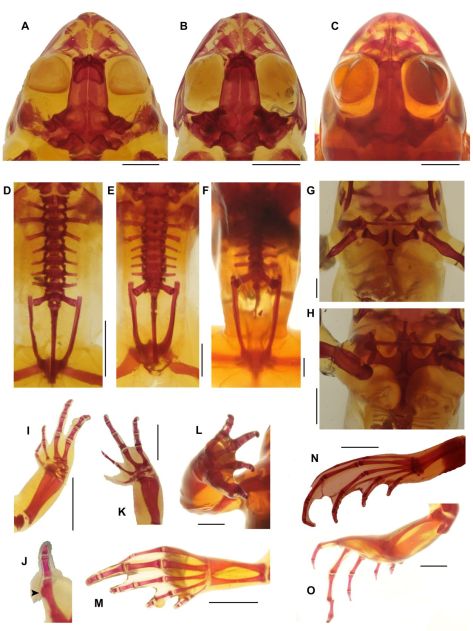NewsNext Previous
New research provides knowledge, for the first time, about the skeleton of the Pyrenean frog and its adaptation to mountain streams with fast-running water
Descending from a more terrestrial ancestor it has opted instead for a more aquatic life
It is in danger of extinction and it is an endemic species from the Pyrenees mountain range, living in the Ordesa and Monte Perdido National Park
When faunal remains are discovered in an archeological site it is not always clear to which species they belong and providing a correct determination is often complex work. Finding a referent in the scientific literature is complicated and sometimes one simply does not exist. In this sense, describing osteologically endemic species from the Iberian Peninsula in order to facilitate their identification in archeological sites or in the diet of other species (pellets) is an essential task that constitutes one of the lines of research of the Institut Català de Paleoecologia Humana i Evolució Social (IPHES).
While it is a species that had been previously identified, all the parts of the skeleton of the Pyrenean frog (Rana pyrenaica) were never described. It is catalogued as an endangered species in the 2007 IUCN Red List of Threatened Species. The fragility of the environments where this frog lives, characterized by pure waters and virgin streams, is the cause of this situation.
 R. pyrenaica was compared with other Iberian brown frogs for a correct osteological identification
R. pyrenaica was compared with other Iberian brown frogs for a correct osteological identification
The Rana pyrenaica (genus and subgenus Rana), is the smallest European brown frog, belonging to the Rana temporaria group, with adults reaching a maximum size of 5.5 cm and a robust morphology. Its ancestor was certainly more terrestrial, related to the common frog (Rana temporaria). However, the species described here became more aquatic, occupying high mountain streams. In its adaptation to this new environment the species developed longer legs and feet (in particular the third digit), some cranial bones (nasal and fronto-parietal) became longer and thinner and the articulation between the atlas and the skull tends to be more flexible. At the same time, the Pyrenean frog retained from its more terrestrial ancestor its generally robust skeletal morphology (despite its small size), the skull proportions, the overall morphology of the maxilla and the sphenetmoid, the degree of fusion between the fronto-parietals, and the lower dorsal crest on the ilium, attachment area of muscles important for locomotion.
The Rana pyrenaica is endemic to the Pyrenean mountain range where it is usually found in cool, well-oxygenated mountain streams with fast-running water, especially during snowmelt in late spring. The R. pyrenaica lives at altitudes ranging from 780 m to 2100 m, being more abundant between 1200 and 1800 m. Its distribution is mainly restricted to the central and western parts of the southern Pyrenean slopes (Aragón and Navarra), from the Ordesa and Monte Perdido National Park in the east, to the Irati area in the west. Some populations have been found as low as 780 m in the Irati forest area, where they also enter into French territory along small ravines belonging to the Ebro watershed.
 Rana Pyrenaica by Óscar Arribas
Rana Pyrenaica by Óscar Arribas
Despite being described in 1993, the skeleton of R. pyrenaica was never been fully investigated. The recent publication by Blain & Arribas thus represents the first description of the osteology of this spring-dwelling Pyrenean small brown frog. In addition to increasing knowledge about R. pyrenaica, this study also aims to render easier the correct diagnosis of the species in fossil assemblages and its osteological identification in the diet of other vertebrates in trophic studies.
Long jumps to enter water and swimming
Brown frogs have several modes of life: some, such as R. temporaria and R. dalmatina, are very terrestrial and only enter still waters for reproduction, but R. pyrenaica only lives on the shores of running waters, and its escape behavior consists of long jumps to enter water and then swim. This mode of life involves swimming against fast-flowing waters, fitting into narrow crevices and anchoring itself among stones to avoid being dragged along by the currents.
Article
Blain H.-A. & Arribas O. (2017). A description of the skeletal morphology of Rana pyrenaica (Anura: Ranidae), with comments on functional morphology, ecological adaptation and relationships with other Iberian ranids. Zootaxa, 4319 (3): 510-530.


